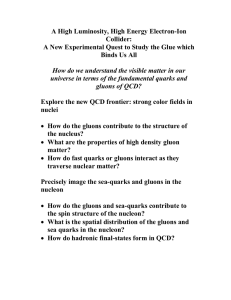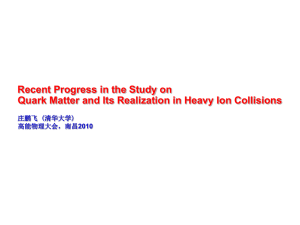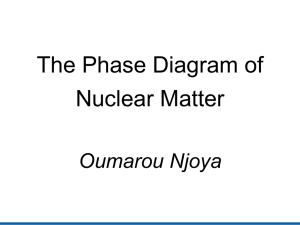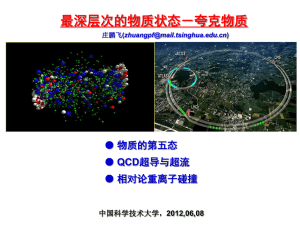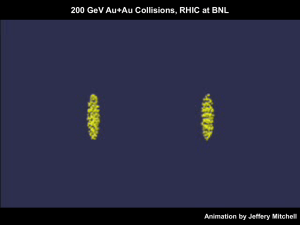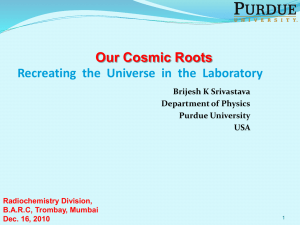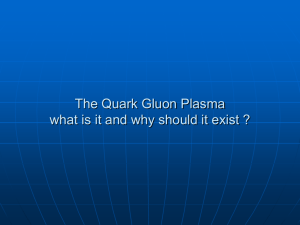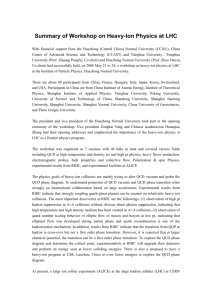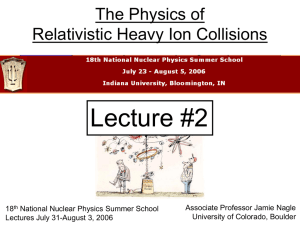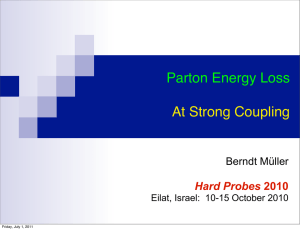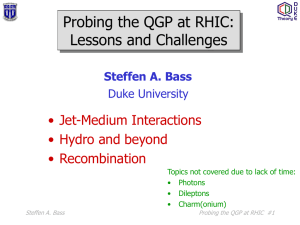A Nearly Perfect Ink !? Theoretical from RHIC Challenges
advertisement
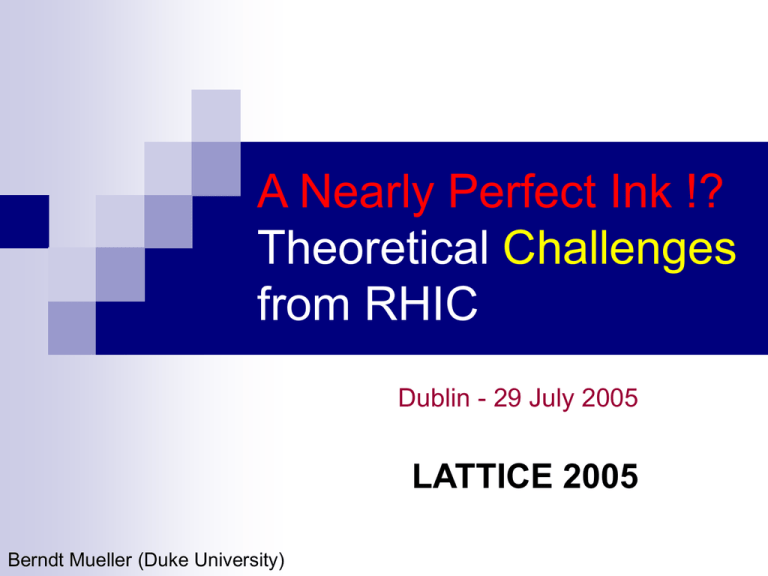
A Nearly Perfect Ink !? Theoretical Challenges from RHIC Dublin - 29 July 2005 LATTICE 2005 Berndt Mueller (Duke University) A perfect ink… Is brilliantly dark and opaque Yet flows smoothly and easily A painful challenge to fountain pen designers A delightful challenge to physicists: Are the two requirements really compatible? Hint: f 1 The road to the quark-gluon plasma …Is hexagonal and 2.4 miles long STAR Two wealths A wealth of … Challenges A wealth of … Challenges Challenges DATA Challenges Cornerstone results from RHIC Anisotropic “Jet” transverse flow suppression Baryon/meson enhancement Azimuthal anisotropy v2 Semiperipheral collisions Coordinate space: initial asymmetry Momentum space: final asymmetry y py x v 2 cos2 , tan 1( py px ) Signals early equilibration (teq 0.6 fm/c) Jet quenching in Au+Au PHENIX Data: Identified p0 No quenching d+Au Quenching! Au+Au Yield(b | AA) R(b) N coll (b)Yield( pp) baryons RCP Baryons vs. mesons pT (GeV/c) mesons f behaves like meson ? (also -meson) Overview QCD Thermodynamics Thermalization How can it be so fast? Transport in a thermal medium What are the dynamical degrees of freedom? Is there a critical point, and where is it? Viscosity, energy loss, collective modes Hadronization Recombination vs. fragmentation QCD phase diagram RHIC T Critical endpoint ? QuarkGluon Plasma Chiral symmetry restored Hadronic matter 1st order line ? Chiral symmetry broken Nuclei Color superconductor Neutron stars B Space-time picture Bjorken formula dET (t ) / dy (t ) dV (t ) / dy (dET / dy )final p RA2t Pre-equil. phase teq (t ) 4.5 GeV/fm3 at t 1 fm/c in Au+Au (200 GeV) Stages of a r.h.i. collision Initial collision ≈ break-up of the coherent gluon field (“color glass condensate”) Pre-equilibrium: the most puzzling stage Equilibrium (T > Tc): hydrodynamic expansion in longitudinal and transverse directions Hadronization: are there theoretically accessible domains in pT ? Hadronic stage (T < Tc): Boltzmann transport of the hadronic resonance gas Initial state: Gluon saturation Gribov, Levin, Ryskin ’83 ~ 1/Q2 Blaizot, A. Mueller ’87 McLerran, Venugopalan ‘94 Qs2 ( x, A) “Color glass condensate (CGC)” xGA ( x, Qs2 ) s (Qs2 ) gluon density area = 2 p RA Qs2 A1/ 3 x 1 2 Qs Details of space-time picture depend on gauge! CGC dynamics Initial state occupation numbers ~ 1/s 1 → classical fields generated by random color sources on light cone: 1 P( a ) P0 exp 2 2 d 2 x [ a ( x )]2 g Qs a ( x ) a ( x ) Aia ( x ,t ) Boost invariance → Hamiltonian gauge field dynamics in transverse plane (x,t). 2-dim lattice simulation shows rapid equipartitioning of energy (teq ~ Qs-1). Krasnitz, Nara & Venugopalan; Lappi (hep-ph/0303076 ) Challenge: (3+1) dim. simulation without boost invariance Saturation and dN/d Kharzeev & Levin Assume nucleus is “black” for all gluons with kT Qs: Qs(x) → Qs(y) with x = Qse-|Y-y| . Also predicts beam energy dependence of dN/dy. Challenge: Pseudorapidity = - ln tan q Rapidity y = ln tanh(E+pL)/(E-pL) How much entropy is produced by simple decoherence, how much during the subsequent full equilibration? The(rmalization) mystery Experiment demands: tth 0.6 fm/c “Bottom up” scenario (Baier, A. Mueller, Schiff, Son): “Hard” gluons with kT ~ Qs are released from the CGC; Released gluons collide and radiate thermal gluons; Thermalization time tth ~ [s13/5 Qs]-1 ≈ 2-3 fm/c Perturbative dynamics among gluons does not lead to rapid thermalization. Quasi-abelian instability (Mrowczynski; Arnold et al; Rebhan et al): Non-isotropic gluon distributions induce exponentially growing field modes at soft scale k ~ gQs ; These coherent fields deflect and isotropize the “hard” gluons. After thermalization… ... matter is described by (relativistic) hydrodynamics ! Requires f L and small shear viscosity . T 0 with T ( P)u u Pg ( u u trace) HTL pert. theory (nf=3): T3 106.7 4 g ln g 1 Dimensionless quantity /s. (Baym…; Arnold, Moore & Yaffe) Classical transp. th.: ≈ 1.5Tf, s ≈ 4 → /s ≈ 0.4Tf. Azimuthal anisotropy v2 Semiperipheral collisions Coordinate space: initial asymmetry Momentum space: final asymmetry y py x v 2 cos2 , tan 1( py px ) Signals early equilibration (teq 0.6 fm/c) – How small can it be? D. Teaney Boost invariant hydro with T0t0 ~ 1 requires /s ~ 0.1. s t0 4 3T0t 0 s s T0t 0 1 N=4 SUSY Yang-Mills theory (g1): /s = 1/4p (Kovtun, Son, Starinets). Absolute lower bound on /s ? QGP(T≈Tc) = sQGP /s = 1/4p implies f ≈ (5 T)-1 ≈ 0.3 d Challenge: (3+1) dim. relativistic viscous fluid dynamics First attempts Challenge: Calculate /s for real QCD t Nakamura & Sakai t 1 d 3 x dt e (t t ) dt Tik ( x, t )T ik ( x, t ) 6 Method: spectral function repr. of Gb and Gret, fit of spectral fct. to Gb. Related (warm-up?) problem: EM conductivity ≈ q2f/2T. SU(3) YM nf = 3 QGP → / ≈ 20 T2. Caveat: f(glue) f(quarks) ret QCD equation of state p 2 30 T Challenge: QCD e.o.s. with light domain wall quarks 20% Challenge: Devise method for determining from data Challenge: Identify the degrees of freedom as function of T Is the (s)QGP a gaseous, liquid, or solid plasma ? 4 A possible method BM & K. Rajagopal, hep-ph/0502174 Eliminate T from and s : p2 T4 30 2 2p 3 s T 45 1215 s 4 s4 0.96 3 2 3 128p Lower limit on requires lower limit on s and upper limit on . Measuring and s Entropy is related to produced particle number and is conserved in the expansion of the (nearly) ideal fluid: dN/dy → S → s = S/V. Energy density is more difficult to determine: Energy contained in transverse degrees of freedom is not conserved during hydrodynamical expansion. Focus in the past has been on obtaining a lower limit on ; here we need an upper limit. New aspect at RHIC: parton energy loss. dE/dx is telling us something important – but what exactly? Entropy Two approaches: 1) 2) Use inferred particle numbers at chemical freeze-out from statistical model fits of hadron yields; Use measured hadron yields and HBT system size parameters as kinetic freeze-out (Pratt & Pal). Method 2 is closer to data, but requires more assumptions. Good news: results agree within errors: dS/dy = 5100 ± 400 for Au+Au (6% central, 200 GeV/NN) → s = (dS/dy)/(pR2t0) = 33 ± 3 fm-3 Jet quenching in Au+Au PHENIX Data: Identified p0 No quenching d+Au Quenching! Au+Au “Jet quenching” = parton energy loss High-energy parton loses energy by rescattering in dense, hot medium. q q Radiative energy loss: dE / dx L kT 2 L Scattering centers = color charges q q Density of scattering centers g d 2 2 qˆ q dq kT 2 dq 2 Scattering power of the QCD medium: 2 Range of color force Energy loss at RHIC Data suggest large energy loss parameter: Eskola, Honkanen, Salgado & Wiedemann qˆ 5 10 GeV2 /fm Dainese, Loizides, Paic RHIC pT = 4.5–10 GeV The Baier plot Plotted against , q̂ is the same for a p gas and for a perturbative QGP. Suggests that q̂ is really a measure of the energy density. Data suggest that q̂ may be larger than compatible with Baier plot. Nonperturbat. calculation is needed. RHIC data sQGP QGP Pion gas Cold nuclear matter Challenge: Realistic calculation of gluon radiation in medium Eikonal formalism Kovner, Wiedemann x quark q ( x ) Wb ( x ; L) qb ( x ) x- L W ( x ; L) P exp i dx A ( x , x ) 0 b Gluon radiation: N g (k ) + s CF ik ( x dx dy e 2p y ) x x = 0 x y 1 C ( x , 0) C (0, y ) C ( x , y ) 2 2 x y with C ( x , y ) Tr[WA† ( x ; L)WA ( y ; L)] N c2 1 Eikonal form. II C ( x , y ) Tr[W † ( x ; L)W ( y ; L) N c2 1 L x 1 2 ( x y ) dx dx F i ( x )W ( x , x ) Fi ( x )W † ( x , x ) 2 0 0 1 1 ( x y ) 2 L F i Fi F ( x y ) 2 Lqˆ 2 2 Challenge: Compute F+i(x)F+i(0) for x2 = 0 on the lattice Not unlike calculation of gluon structure function, maybe moments are calculable using euclidean techniques. Where does Eloss go? STAR Away-side jet p+p Au+Au Trigger jet Lost energy of away-side jet is redistributed to rather large angles! Wakes in the QGP J. Ruppert and B. Müller, Phys. Lett. B 618 (2005) 123 Angular distribution depends on energy fraction in collective mode and propagation velocity Mach cone requires collective mode with w(k) < k: Colorless sound ? Colored sound = longitudinal gluons ? Transverse gluons T. Renk & J. Ruppert Yield(b | AA) R(b) N coll (b)Yield( pp) baryons RCP Baryons vs. mesons pT (GeV/c) mesons f behaves like meson ? (also -meson) Hadronization mechanisms q q q q q qq q Recombination Fragmentation Baryon Meson 1 Baryon 1 Meson pM 2 pQ pB 3 pQ Recombination wins… … for a thermal source Fragmentation dominates for a power-law tail Baryons compete with mesons Quark number scaling of v2 In the recombination regime, meson and baryon v2 can be obtained from the quark v2 : pt v pt 2 v 2 M 2 q 2 pt v pt 3v 3 B 2 q 2 Hadronization RHIC data (Runs 4 and 5) will provide wealth of data on: Identified hadron spectra up to much higher pT (~10 GeV/c); Elliptic flow v2 up to higher pT with particle ID; Identified di-hadron correlations; Spectra and v2 for D-mesons…. Challenge: Unified framework treating recombination as special case of QCD fragmentation “in medium”. A. Majumder & X.N. Wang, nucl-th/0506040 D fragmentation D recombination Some other challenges Where is the QCD critical point in (,T)? What is the nature of the QGP in Tc < T < 2Tc ? How well is QCD below Tc described by a weakly interacting resonance gas? Thermal photon spectral function (m2,T). Are there collective modes with w(k) < k ? Can lattice simulations help understand the dynamics of bulk (thermal) hadronization? Don’t be afraid… “Errors are the doors to discovery” James Joyce Back-up slides Hard-soft dynamics k ~ gQs Nonabelian Vlasov equations generalizing “hard-thermal loop” effective theory. Can be defined on (spatial 3-D) lattice with particles described as test charges or by multipole expansion (Hu & Müller, Moore, Bödeker, Rummukainen). k ~ Qs D F gJ J ( x) dt Qi (t )ui (t ) ( x xi (t )) i ˆ light-like ui (1, v) Poss. problem: short-distance lattice modes have wrong w(k). Challenge: Full (3+1) dim. simulation of hard-soft dynamics Reco: Thermal quarks Relativistic formulation using hadron light-cone frame: w (r , p) Quark distribution function at “freeze-out” E 2 dN M P u d dxw ( R , xP ) w ( R , (1 x ) P ) f ( x ) b M d 3P (2p )3 , b E 2 dN B P u d dxdx ' w ( R , xP ) w ( R , x ' P ) w ( R , (1 x x ') P ) f ( x , x ') b B d3 p (2p )3 , b , For a thermal distribution, w(r , p) exp( p u / T ) the hadron wavefunctions can be integrated out, eliminating the model dependence of predictions. Remains exactly true even if higher Fock states are included! Heavy quarks Heavy quarks (c, b) provide a hard scale via their mass. Three ways to make use of this: Color screening of (Q-Qbar) bound states; Energy loss of “slow” heavy quarks; D-, B-mesons as probes of collective flow. RHIC program: c-quarks and J/Y; LH”I”C program: b-quarks and . RHIC data for J/Y are forthcoming (Runs 4 & 5). J/Y suppression ? Vqq is screened at scale (gT)-1 heavy quark bound states dissolve above some Td. Color singlet free energy Quenched lattice simulations, with analytic continuation to real time, suggest Td 2Tc ! S. Datta et al. (PRD 69, 094507) Karsch et al. Challenge: Compute J/Y spectral function in unquenched QCD C-Cbar kinetics J/Y RHIC LHC J/Y, can be ionized by thermal gluons. If resonances persist above Tc, J/Y and can be formed by recombination in the medium: J/Y may be enhanced at LHC! Challenge: Multiple scattering theory of heavy quarks in a thermal medium RHIC LHC Analogous to the multiple scattering theory for high-pT partons, but using methods (NRQCD etc.) appropriate for heavy quarks.
